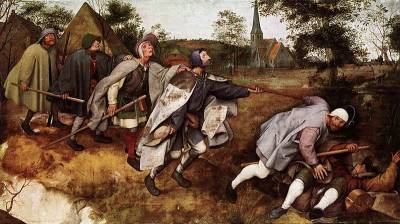|
Pieter Brueghel the Elder
|
|
| Rina | Date: Thursday, 12.04.2012, 15:01 | Message # 1 |
 Union committee president
Group: Friends
Messages: 208
Status: Offline
| In this thread we are going to discuss the artistic heritage of Brueghel.
|
| |
|
|
| Rina | Date: Thursday, 12.04.2012, 15:03 | Message # 2 |
 Union committee president
Group: Friends
Messages: 208
Status: Offline
| Asya and Rina:
We'd like to describe the painting “The tower of Babel” as it is considered to be one of the most well-known Brueghel's works. We have also found out that the Tower of Babel was one of the leading motives in Brueghel's artistic heritage.
Bruegel's depiction of the architecture of the tower, with its numerous arches and other examples of Roman engineering, is deliberately reminiscent of the Roman Colosseum, which Christians of the time saw as both a symbol of arrogance and persecution. The parallel of Rome and Babylon had a particular significance for Bruegel's contemporaries: Rome was the Eternal City, intended by the Caesars to last for ever, and its decay and ruin were taken to symbolize the vanity of earthly efforts.
In the foreground of the picture we see a truly magnificent tower that occupies almost all the space of the painting. It seems to be enormously huge being compared with minuscule houses in the background. But in spite of its grandeur it is far from being perfect. It is half-ruined just as Colosseum, its prototype . Better than any technical trick chiaroscuro brings out the picture's basic atmosphere, accentuating the Tower itself. We see that its half-destroyed top is hidden behind the cloud that can stand for Heaven, symbolizing people's inability to reach the divine kingdom.
|
| |
|
|
| Ayayulia | Date: Thursday, 12.04.2012, 15:22 | Message # 3 |
 Union organizer
Group: Friends
Messages: 126
Status: Offline
| Peter Bruehel the Elder followed Bosch’s ideas. He is also characterised by panoramic landscape filled with figures seen above. The death’s images were the same, as Bosch had created. One of his main themes was peasant life with its realities and pleasures. Here he excelled his predecessors in force and truthfulness. Bruehel discovered the inner being of man and its essential realities; that is why he sometimes departs from ideals of formal beauty and from religious view of the world.

|
| |
|
|
| Teacher | Date: Thursday, 12.04.2012, 16:01 | Message # 4 |
 Head teacher
Group: Admins
Messages: 375
Status: Offline
| Breughel and Bosch had similar styles, but still there were some differences. Breughel’s view on people is more sober. His pictures depict different social classes of people. One can see poor and handicapped people in one of Breughel’s pictures “The Blind Leading the Blind”. The artist drew his work in Flemish tradition of realism. The moment depicted in the picture is dramatic, but still ironical. Breughel always tried to reveal the essential reality of human being’s nature. The painting is based upon a saying of Jesus that appears in the Gospels: “Can the blind lead the blind? Will they not both fall into the ditch?” These six blinds are symbol of Humanity existing without faith. And on the contrast, there is a church on the background representing the faith which gives true vision. Very often Bruegel gives a particular and realistic interpretation to a Christian moral in his works. Besides depicting of blind people is one of major motif in Breughel’s oeuvre.

In Vino Veritas...
|
| |
|
|
| Megastarosta | Date: Thursday, 12.04.2012, 21:58 | Message # 5 |
 Union organizer
Group: Friends
Messages: 126
Status: Offline
| Peter Brueghel the Elder adapted Bosch’s strategy (he rejected the human point of view of man as a reasonable creature, capable of noble aspirations, infinitely perfectable)- the panoramic landscape filled with small busy figures seen from above - to his own sober view of human life. His allegorical “Triumph of Death” portrays a great variety of contemporary social types - young and old, rich and poor, - each being carried off by a skeleton
|
| |
|
|












